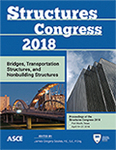Structures Congress 2018
Selection of Concrete Mix Design Types for Petrochemical Structures
Publication: Structures Congress 2018: Bridges, Transportation Structures, and Nonbuilding Structures
ABSTRACT
The selection of concrete mix design types affects the performance and constructability of petrochemical projects. There are many concrete mix design types that may be required for industrial projects including: controlled low-strength material, cellular concrete, self-consolidating concrete, high performance concrete, and chemical-resistant concrete. Each of these mix designs has unique properties and each has a specific use for petrochemical projects. Petrochemical structures have distinctive loading and durability demands due to their exposure to harmful chemicals and interaction with large mechanical equipment and piping systems. Revamp and retrofit projects should be done while the facility is in operation to minimize business interruption. If concrete work has to be done during a shutdown then the work must be done in a short duration. Specifying the proper mix design, therefore, is critical to the performance and constructability of a petrochemical structure.
Get full access to this article
View all available purchase options and get full access to this chapter.
REFERENCES
ACI (1994) “Controlled Low Strength Materials (CLSM)”, American Concrete Institute Committee 229, Report ACI 229R, Farmington Hills, Michigan 1994.
ACI (2006) “Guide for Cast-in Place Low Density Cellular Concrete”, American Concrete Institute Committee 523, Report ACI 523R, Farmington Hills, Michigan, 2006.
ACI (2017) Reinforced Concrete Code ACI 318, American Concrete Institute, Farmington Hills, Michigan, 2017.
Adamczyk (2015) “Cellular Concrete – The Material of Sustainable Construction”, Technical Issues 1/2015, ISSN, 2015.
Bernabeu and Redon (2007). Self Compacting Concrete for LNG Tanks Construction in Texas, Proceedings of 5thInternational RILEM Symposium on Self-Compacting Concrete, 939–944.
Carino (1999) “Curing of High Performance Concrete, what is Sufficient?” National Institute of Standards and Technology, 1999
Claus Nielsen (2007). Does SCC really improve the working environment? Proceedings of 5thInternational RILEM Symposium on Self-Compacting Concrete, 939–944
DER (2015) “Identification and Investigation of Acid Sulfate Soils”, Government of Western Australia, Department of Environment Regulation, DER2015001427, June 2015.
Luo, S. & Zheng, J. (2005). Study on the application of self-compacting concrete in strengthening engineering, Proceedings of 1stInternational RILEM Symposium on Self-Compacting Concrete, 633–640.
Okamura, H. & Ouchi, M. (2004). Self-Compacting Concrete. Journal of Advanced Concrete Technology, 1, 5–15.
Pai, B. V. B. (2004). How economic is self-compacting concrete. The India concrete Journal, 6, 58–59.
Persson, B. (2003). Internal frost resistance and salt frost scaling of SCC. Cement and Concrete Research, 373–379.
Repette, W. (2007). Self-Compacting Concrete – A labor cost evaluation when used to replace traditional concrete in building construction, Proceedings of 5thInternational RILEM Symposium on Self-Compacting Concrete, 1001–1006.
Thomas (2007) “Optimizing the Use of Fly Ash in Concrete”, Michael Thomas, Portland Cement Association, Report IS548, Skokie, IL 2007.
Tikalsky (1989) “The Effect of Fly Ash in Sulfate Resistance of Concrete”, Tikalsky & Carrasquillo, Center for Transportation Research, Report 481-5, University of Texas at Austin, Austin, TX 1989.
Tragardh, J., Skoglund, P., & Westerholm, M. (2003). Frost resistance, chloride transport and related microstructure of field self-compacting concrete. Proceedings of the 3rdInternational RILEM symposium on self-compacting concrete, 881–891.
Zhu, W. & Bartos, P. J. M. (2003). Permeation properties of self-compacting concrete. Cement and Concrete Research, 6, 921–926.
Information & Authors
Information
Published In
Structures Congress 2018: Bridges, Transportation Structures, and Nonbuilding Structures
Pages: 400 - 407
Editor: James Gregory Soules, CB&I
ISBN (Online): 978-0-7844-8133-2
Copyright
© 2018 American Society of Civil Engineers.
History
Published online: Apr 17, 2018
Authors
Metrics & Citations
Metrics
Citations
Download citation
If you have the appropriate software installed, you can download article citation data to the citation manager of your choice. Simply select your manager software from the list below and click Download.
